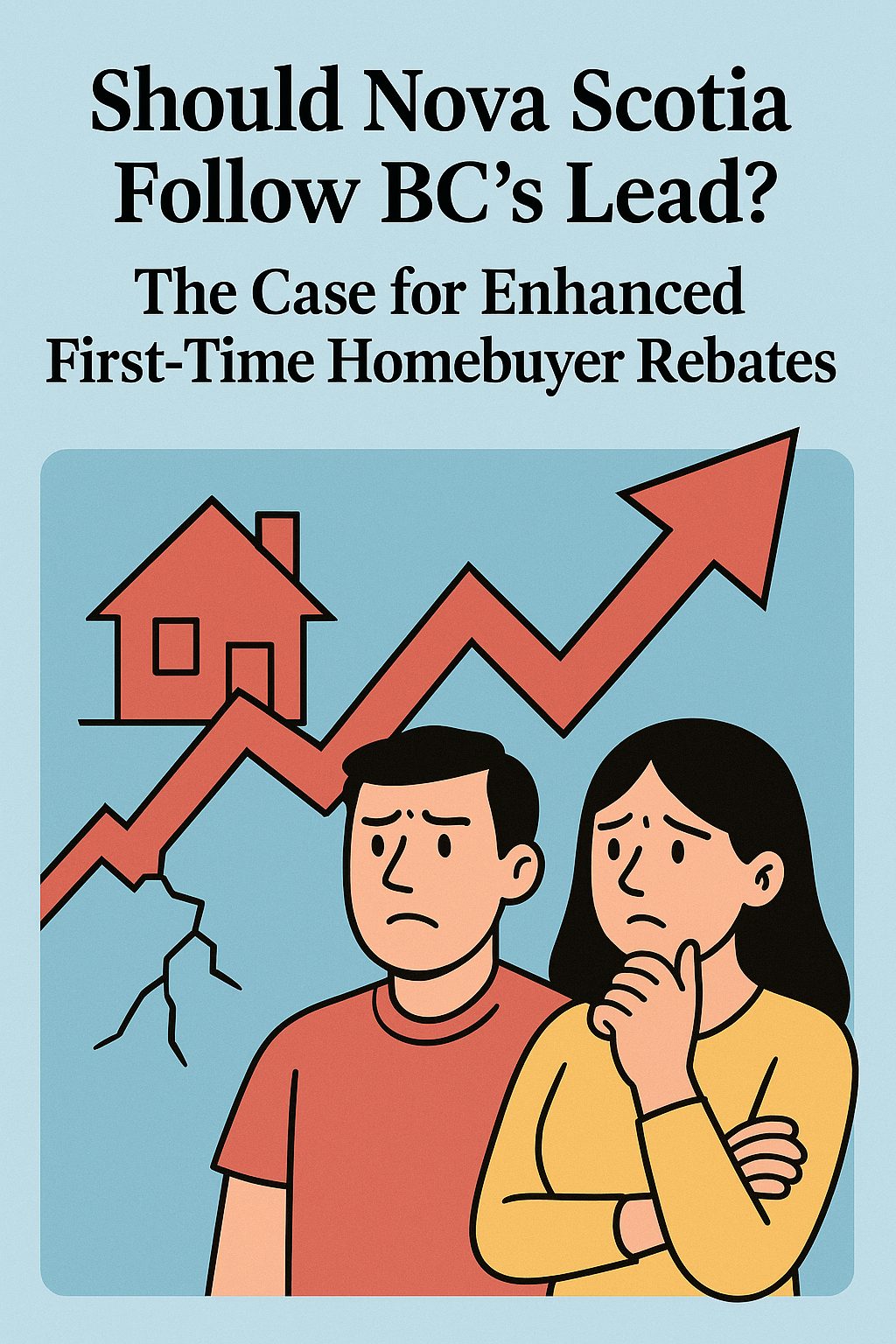Nova Scotia’s Housing Challenge: Time for a First-Time Buyer Rebate Boost?
As federal support for homebuyers expands, Nova Scotia faces pressure to step up its own assistance programs
The dream of homeownership feels increasingly out of reach for many young Nova Scotians. Between skyrocketing home prices and the everyday costs of living, saving for a down payment while paying rent has become a financial juggling act that leaves many feeling defeated before they even start house hunting.
But recent developments in Ottawa have sparked fresh hope—and fresh debate about what provinces should be doing to help. With new federal tax breaks on the horizon, the spotlight is now on provincial governments to decide whether they’ll match this momentum or stick with the status quo.
Ottawa Steps Up: What’s New for Homebuyers
The federal government recently unveiled plans to eliminate GST on newly built homes for first-time buyers—a move that could save eligible purchasers up to $50,000. Under the proposed legislation, buyers purchasing new homes under $1 million would pay no federal sales tax, while those buying homes between $1 million and $1.5 million would receive partial rebates.
The eligibility requirements are refreshingly straightforward. Buyers need to be Canadian citizens or permanent residents, at least 18 years old, and haven’t owned a home in the past four years. The property must serve as their primary residence, and the rebate applies to new construction purchases, custom builds, and co-op housing shares.
For a young couple looking at a $400,000 new home in Halifax, this federal rebate could mean $20,000 back in their pockets—money that could cover moving costs, furniture, or even help with future mortgage payments.
What Nova Scotia Currently Offers
Nova Scotia hasn’t ignored first-time buyers entirely. The province runs its own rebate program that returns 18.75% of the provincial HST portion on new home purchases, maxing out at $3,000. While every bit helps, this amount pales in comparison to what the federal program promises.
The provincial program also comes with stricter rules. Buyers must wait five years since their last home ownership (longer than the federal four-year requirement) and the rebate only applies to brand-new construction—no existing homes qualify.
Beyond this rebate, Nova Scotia offers various programs for developers and property investors, plus energy efficiency incentives. However, none of these specifically tackle the unique financial hurdles facing first-time buyers trying to break into today’s market. Even with the small rebate Nova Scotia is offering, there are still more closing costs to consider. To learn more about the closing costs to buy in Nova Scotia, please click here
Why Nova Scotia Might Need to Do More
The Affordability Reality Check
Anyone who’s been house hunting in Nova Scotia lately knows the numbers are sobering. What used to be considered “starter home” prices now feel like luxury purchases for many young professionals and families. The gap between earnings and housing costs continues to widen, leaving potential buyers feeling stuck in rental markets with little hope of building equity.
This isn’t just a personal finance problem—it’s an economic development issue. When young professionals can’t afford to buy homes, they’re more likely to consider opportunities in other provinces or cities where homeownership feels achievable. Nova Scotia risks losing talent to jurisdictions that offer better pathways to property ownership.
Following the BC Blueprint
British Columbia has built a reputation for creative and generous homebuyer support programs. Despite facing some of Canada’s most expensive housing markets, BC has maintained programs that help first-time buyers navigate the challenges of homeownership.
BC’s approach combines higher rebate amounts with innovative financing options and targeted support for different buyer segments. The province recognizes that helping residents transition from renters to owners strengthens communities and creates economic stability.
If Nova Scotia adopted a similar comprehensive approach, it could become more competitive in attracting and retaining young professionals, particularly in growing sectors like technology and healthcare where talent mobility is high.
The Other Side of the Coin
Budget Realities
Every government program comes with costs, and provincial budgets face constant pressure from competing priorities. Healthcare, education, infrastructure, and social services all demand funding, making it challenging to allocate significant resources to housing rebates.
There’s also the question of targeting. Should limited provincial dollars go toward rebates that primarily benefit those who can already afford homeownership, or would the money be better spent on affordable housing initiatives that help lower-income residents?
Federal Coverage Might Be Enough
The new federal rebate represents a substantial improvement over the current situation. For many potential buyers, saving $20,000 to $50,000 on their purchase might be exactly the boost they need to make homeownership feasible without additional provincial support.
Adding provincial programs on top of federal ones could create administrative complexity and potentially drive up home prices if increased buyer demand outpaces housing supply.
What Enhanced Support Could Look Like
If Nova Scotia decided to boost its first-time buyer support, several options could make a meaningful difference:
Increased Rebate Amounts: Raising the maximum provincial rebate from $3,000 to $10,000 or $15,000 would provide more substantial relief while remaining fiscally manageable.
Expanded Eligibility: Allowing rebates on existing homes, not just new construction, would help buyers access a broader range of properties in established neighborhoods.
Down Payment Assistance: Programs that provide forgivable loans or shared equity arrangements could help buyers overcome the down payment hurdle that stops many from even applying for mortgages.
Combined Programs: Creating a comprehensive support package that addresses multiple barriers to homeownership, from down payments to closing costs to moving expenses.
The Competitive Landscape
Nova Scotia doesn’t operate in isolation. Other provinces are watching federal developments and considering their own responses. Prince Edward Island, New Brunswick, and Newfoundland all compete for similar demographics and face comparable housing challenges.
The province that creates the most attractive and accessible pathway to homeownership will have an advantage in economic development and population growth. With Nova Scotia’s tech sector expanding and Halifax emerging as an Atlantic Canadian hub, the timing for enhanced homebuyer support could be strategic.
Making the Case for Action
The federal GST rebate creates a unique opportunity for Nova Scotia to amplify support for first-time buyers without bearing the full cost burden alone. By layering provincial incentives on top of federal ones, the province could create a compelling value proposition for young professionals and families.
Consider the multiplier effects: first-time buyers don’t just purchase homes—they invest in renovations, buy appliances and furniture, hire local contractors, and contribute to the tax base through property taxes. These economic activities create jobs and generate revenue that benefits the broader community.
Moreover, homeownership provides stability that extends beyond individual families. Homeowners are more likely to invest in their communities, participate in local organizations, and provide the stable neighborhoods that attract businesses and additional residents.
A Window of Opportunity
The combination of federal support and provincial opportunity creates a unique moment for Nova Scotia to make homeownership more accessible. While budget constraints and competing priorities present real challenges, the potential benefits of enhanced first-time buyer support extend well beyond individual purchases.
By following British Columbia’s example and building on federal initiatives, Nova Scotia could position itself as a leader in housing affordability solutions. The question isn’t just whether the province can afford to enhance these programs—it’s whether it can afford to miss this opportunity to strengthen its competitive position and support the next generation of Nova Scotian homeowners.
The decisions made in the coming months will influence housing accessibility and economic development for years to come. For thousands of potential first-time buyers currently watching from the sidelines, those decisions could determine whether the dream of homeownership becomes an achievable goal or remains frustratingly out of reach.
This article provides general information about housing programs and should not be considered financial or legal advice. Prospective homebuyers should consult with qualified professionals to understand how current and proposed programs might apply to their specific circumstances.

 Facebook
Facebook
 X
X
 Pinterest
Pinterest
 Copy Link
Copy Link

